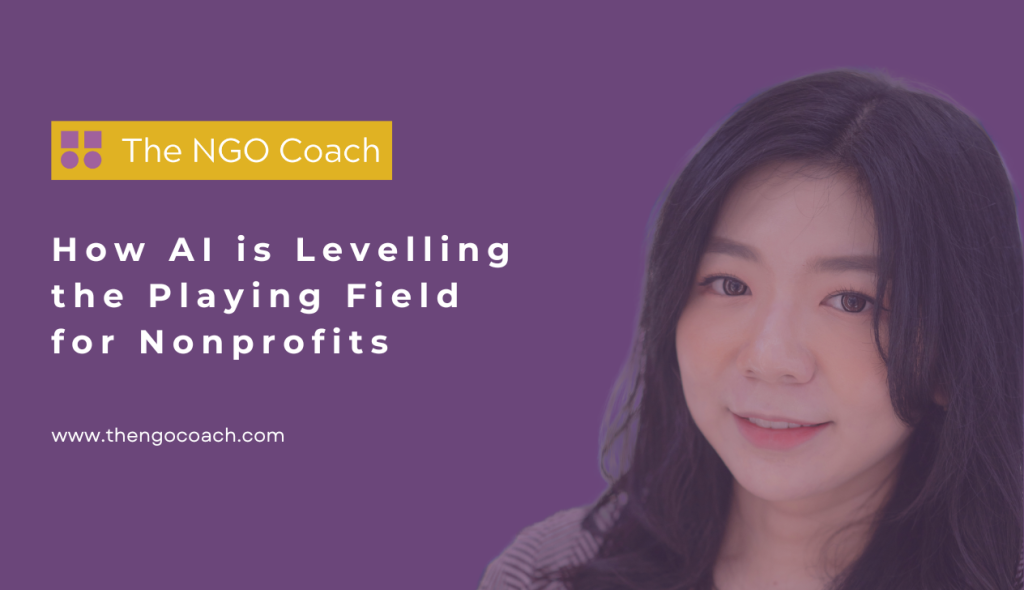For decades, small nonprofits have struggled against a system that favours the big players. Government and philanthropic funding models have long been inequitable, creating barriers for smaller organisations that lack the resources, connections, and professional expertise to compete. Larger nonprofits have the advantage of experienced grant writers—individuals who are trained to write in a voice that funders recognise and value. Meanwhile, smaller organisations, often grassroots and deeply embedded in their communities, simply don’t have access to these skills. They enter the grant application process at a disadvantage, long before they even hit “submit.”
But AI is changing the game.
Leveling the Playing Field in Grant Writing
One of the most significant ways AI is democratising nonprofit life is through grant writing. AI-powered tools can:
- Significantly speed up and simplify the process of grant writing, reducing the time it takes to pull together an application from weeks to hours.
- Write in a voice that funders recognise, increasing the likelihood of an application being taken seriously.
- Support untrained grant writers by structuring proposals in ways that align with funding criteria.
- Analyse successful past applications to identify patterns and key phrases that funders favour.
For years, small nonprofits have been stuck in a cycle of underfunding, often because they simply didn’t have the capacity to write applications that could compete with those from well-resourced organisations. AI isn’t a magic bullet, but it is an equaliser—giving smaller charities a fighting chance to access the funding they deserve.
AI and the Power of Storytelling
Funders don’t just look at the numbers—they want to see impact. Nonprofits have incredible stories to tell, but often lack the capacity or confidence to craft compelling narratives. AI tools can help:
- Refine storytelling for funding applications, making impact stories more compelling and data-driven.
- Generate blog posts, social media updates, and donor newsletters, keeping supporters engaged with minimal effort.
- Tailor messaging for different audiences, ensuring funders, volunteers, and donors receive communications that resonate.
- Automate reporting and impact measurement, helping organisations clearly demonstrate their outcomes to funders.
By harnessing AI, small nonprofits can enhance their storytelling, making their work more visible and impactful.
Streamlining Communications & Marketing
Consistent communication is key to maintaining donor engagement, attracting volunteers, and raising awareness. Yet, for many small nonprofits, marketing and comms often fall by the wayside due to lack of time or expertise. AI can help by:
- Writing and scheduling social media content across multiple platforms, ensuring regular engagement.
- Generating newsletters and email campaigns, allowing nonprofits to communicate with their supporters effortlessly.
- Creating personalised donor thank-you messages, improving donor retention without adding extra admin burden.
- Translating content into multiple languages, breaking down language barriers and improving accessibility.
With AI, small teams can maintain a robust online presence without burning out.
Other Ways AI Can Democratise Nonprofit Life
Beyond grant writing and communications, AI has the potential to ease the burden on nonprofit leaders in numerous other ways:
- Data Analysis: AI can analyse donor and volunteer data, helping organisations identify trends and make data-driven decisions.
- Automated Meeting Notes: AI-powered transcription services can summarise board meetings, making governance more efficient.
- Chatbots for Donor and Volunteer Support: AI chatbots can answer common questions, freeing up human capacity for more complex tasks.
- AI-Powered Fundraising Strategies: AI tools can suggest optimised fundraising approaches based on donor behaviour and historical giving patterns.
A Step Towards Greater Equity
For years, the funding landscape has favoured those who can afford the best writers, strategists, and communicators. AI isn’t a solution in itself—human insight, ethical considerations, and strategic thinking are still crucial—but it is an incredible tool that helps level the playing field.
Smaller nonprofits, often the lifeblood of their communities, now have a real opportunity to compete for funding, tell their stories effectively, and operate more efficiently. If we’re serious about equity in the nonprofit sector, embracing AI is a step towards ensuring that all organisations—regardless of size—have a fair shot at sustainability and impact.
The future of nonprofit work isn’t just about working harder—it’s about working smarter. AI is here, and it’s time for nonprofits to harness its potential.

